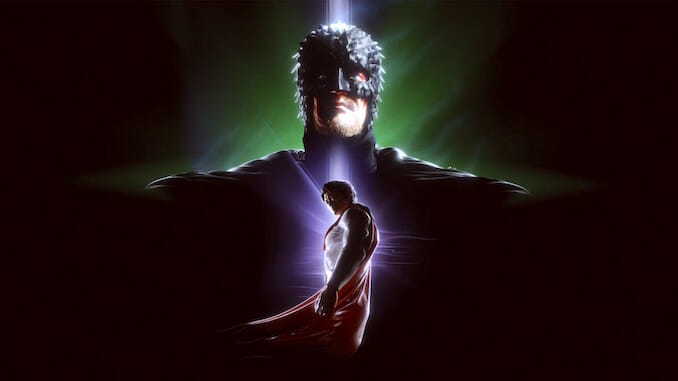The Guardians of Justice (Will Save You): Bizarre, Loud, Fantastical Pulp That Rises to the Moment
Photo Courtesy of Netflix
The Guardians of Justice (Will Save You) is a pastiche and an homage: it’s action and comedy, it’s live-action and animated, it’s magnificent trash that is frenetic and, in the end, surprisingly thoughtful. It’s sharp but unclean, intentionally grimy and purposefully frayed to give the appearance and remembrance of old times and old technologies. Imagine if Turbo Kid was based on a mishmash of the Justice League and G.I. Joe instead of Mad Max, put it in a media scrambler with an ensemble cast and a huge team of animators, and allowed to stretch its legs across seven relatively brief episodes while producing the effect of a long-running franchise that had its many adaptations spliced together.
The Guardians of Justice is set in an alternate universe version of 1987, 40 years after the appearance of a Superman-like figure that halted World War III started by a cyborg-resurrected Hitler. The show begins with Knight Hawk’s (Diamond Dallas Page) investigation of the apparent suicide by that Marvelous Man (Will Yun Lee). Knight Hawk suspects foul play, and soon casts suspicion upon fellow Guardians: The Speed (Sharni Vinson), Awesome Man (Derek Mears), Golden Goddess (Preeti Desai), Black Bow (Tiffany Hines), Blue-Scream (Jackson Rathbone), and King Tsunami (Kellen Lutz). In addition to narrating, series creator Adi Shankar casts himself twice as antagonists (billionaire arms manufacturer/superhero skeptic Logan Lockwood and supervillain terrorist The Scottish Skull) alongside Queen Anubis (Brigitte Nielsen leading a nation-state whose aesthetic is Cobra Command meets the KKK), and the enigmatic Addison Walker (Jane Seymour). Walker runs a global private military company concerned with economic stability and funded by the corporations whose logos have replaced stars on the U.S. flag, a sort of corporate robot army failsafe to prevent the nuclear war which seems imminent after Marvelous Man’s demise.
Just as Dungeons and Dragons campaigns have turned into fantasy novel series and the FromSoftware “Soulsborne” games draw on director Hidetaka Miyazaki reading books beyond his reading comprehension as a child, this feels like an early adolescent smashing action figures together in a bedroom or sandbox and making up a story to go along. It’s endearing that way, but I say adolescent rather than a child because it’s a hyper-violent story whose characters experience drug-use, homophobia, and irredeemably crooked police while on the precipice of Armageddon. The Guardians of Justice is bloody and gory, playing effectively for shock, maintaining a tone throughout that would allow the dimmest of edgelords to go along without thinking thematically, before an ending arc that revokes that privilege, paying off plants, tying up loose ends, and demanding its audience the price of peace—perhaps not unlike another unorthodox superhero show.
The plot concludes by surpassing the need to draw meaning from the meaningless into genuine commentary on American consumerism and militarism. It’s a decidedly unhappy ending that could allow for a second season but does not demand one. The Guardians of Justice uses spectacle to consider marketing and propaganda: its over-the-top, in-your-face style distracts enough to sneak ideas past its audience. Even if the themes fell flat shorn from their unique packaging (and I don’t think they would), the show would still be worth consideration because it is visually daring, standing distinct even as it draws repeatedly from the recognizable.
The abundance of mainstream, nostalgia-plumbing superhero entertainment is the second greatest monkey’s paw-fulfilled wish of my childhood. While the majority of the genre’s mainstream has sanded edges, the purchasing public doesn’t lack for brutal or excessively violent comic book adaptations. Netflix is home to Jupiter’s Legacy and Umbrella Academy; Hulu has a Modok show and Hit-Monkey. On Amazon Prime, there are two brutal shows that deconstruct archetypes of silver age superheroism in The Boys and Invincible, in addition to HBO Max’s Peacemaker, Harley Quinn, and their 2019 adaptation/sequel Watchmen. A new Batman movie that positions itself as neo-noir is in theaters now. Yet even as these contributions debate the political ethos of superheroes or challenge the predominant visual style, none of their creators have attempted what Adi Shankar and his collaborators pull off here visually.
Not many shows combine more than eight different art styles, interchanging different forms of retro arcade side-scrolling beat-em-ups with Claymation, stop-motion, CGI, and drawn animation evoking series like Superfriends, Dragon Ball Z, and 1980s Marvel Comics, among others. There’s live-action that looks contemporary and live-action that looks like Batman ‘66 and Batman v Superman fused together. There are also laser guns that look like Halo battle rifles, a computer that combines the X-Men’s Cerebro with DC villain Brainiac, and repeated references to Mortal Kombat fatalities. There are scenes set in first-person with a shooting-game HUD highlighting close-up gun-kata and a character evoking Snake Plissken. The Guardians of Justice imagines if Amalgam Comics met Watchmen while set to an electro pop/rock background with visual effects that leaned into camp. No less than five animation and graphic design teams worked on this project.
-

-

-

-

- Curated Home Page Articles By Test Admin October 21, 2025 | 3:10pm
-

- Curated Home Page Articles By Test Admin October 21, 2025 | 2:57pm
- Urls By Test Admin October 21, 2025 | 2:57pm
- Curated Home Page Articles By Test Admin October 21, 2025 | 2:55pm
-

-

-

-

-

-

-

-

-

-

-

-

-

-

-

-

-

-

-

-

-

-

-

-

-

-

-

-

-

-

-




































